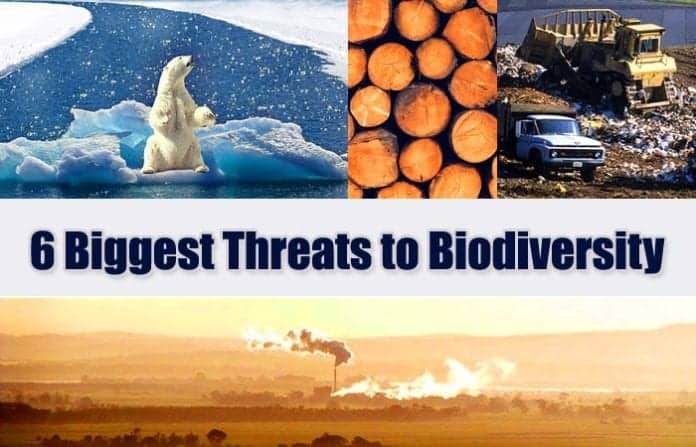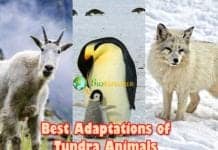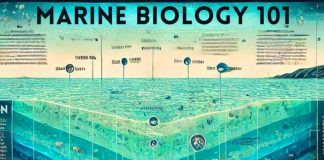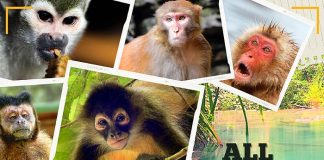Threats To Biodiversity : Biodiversity[1] , which literally means “the diversity of life “, refers to the variety of life forms on Earth. This diversity[2] includes all the variations that exist in all levels of biological organization
But remember that biodiversity is more than just species. To correctly classify life forms, the diversity among different habitats and ecosystems and the diversity among individuals regarding genetic makeup should be considered.
Biodiversity is vital to boost productivity in ecosystems where species depend on to live. However, a lot of man-made activities impose huge impacts on biodiversity.
Below, we discuss six of the major threats to biodiversity: climate change , habitat loss and degradation , pollution , invasive species , over-exploitation and epidemics . Learn how serious these threats are in contributing to the loss of biodiversity in our planet.
Threats To Biodiversity
1. Climate Change
Climate change[3] refers to the long term and irreversible change that occurs in the Earth’s climate. This increase in the atmosphere’s temperature has major effects on the environment such as the seasons, rising sea levels, and glacial retreats.
Organisms’ biodiversity is affected by their population, distribution, level of the ecosystem, and even the individuals’ morphology and function. Because of the increase in temperature, organisms have already adapted by expanding their ranges in latitudes. Because of this behavior, many species’ populations have declined. Aside from this, many animals Regarding ecosystems, studies revealed that climate change has expanded many desert ecosystems and thus affected the function and services that the ecosystem can provide. For humans, the rapidly increasing rate of climate change[4] imposes great threats to human security as natural resources are becoming more and more limited. Global warming and climate change already have irreversible impacts on biodiversity. And these effects, if not mitigated, can lead to more significant threats in the future.
2. Habitat Loss and Degradation
Habitat loss[5] refers to changes in the environment that result to the rendering of a specific habitat to be functionally valuable. The habitat can no longer accommodate and support the life of the organisms present, thereby declining their population.
Natural events like natural calamities, geological events, or anthropogenic activities like deforestation and man-induced climate change may cause Habitat loss. In habitat degradation, the organisms that were once living in a particular area or region are displaced and forced to relocate; thus resulting in biodiversity reduction. Indeed, man-made efforts are the prime reasons for habitat loss. Currently, clearing out ecosystems for agriculture conversion and industrial expansion continues to displace organisms of their natural habitat. Other activities include logging and mining.
3. Pollution
Be it water, air, or land pollution, all forms of pollution[6] appear to be a threat to all life forms on Earth. However, it poses a major threat to biodiversity regarding the nutrient loading of nitrogen and phosphorus elements.
In Europe, atmospheric nitrogen is the only pollutant that has not decreased in concentration since the implementation of legislation. Its mere presence poses huge challenges to the conservation measures intended to natural habitats and species living there. Furthermore, nitrogen compounds in water systems can cause eutrophication (excessive plant and algal growth). The presence and accumulation of phosphorus in water systems can alter how food webs function. Excessive phosphorus, like nitrogen, can result in the uncontrolled growth of planktonic algae Another form of pollution that can damage and kill living organisms is acid rain. Acid rain[7] , as its name suggests, is rain that is composed of harmful acids (i.e., nitric and sulfuric acid). This rain is usually a result of pollution from the excessive burning of fossil fuels. Some types of pollution, like the depletion of the ozone layer, can be reversible. However, this shall only happen when humans stop or limit the use of various chemicals contributing to its destruction.
4. Invasive Species
An exotic or unnatural species can be any organism that has been introduced to a foreign habitat. This introduction can cause major threats to the native species as they often become subject to great competition for resources, disease, and predation. When these species have successfully colonized the area, they are already called “invasive ” ones.
Next to habitat loss, invasive species are ranked as the second biggest threat to biodiversity. The greatest threat that invasive species[8] can bring is their capability to change an entire habitat. These species are highly adaptable and can easily dominate a certain area. Because many natural species survive only in a particular environment, they tend to be displaced or perish. Some places have very low possibilities for species invasion. Usually, these places include those with harsh environmental conditions like extreme temperatures and high salinity. Invasive Species Examples Brown Tree Snake here .
Hawaiian Duck Vs. North American Mallard University of California for more coverage on this.
Beavers here for further readings on this news.
Most exotic species are brought to a certain place to replace or add something to the vegetation. It is important to note that not all introduced species become invasive. Most of these attempts have become successful.
5. Overexploitation
Overexploitation[9] refers to the act of overharvesting species and natural resources at rates faster than they can sustain themselves in the wild. Because of this, the species population is put at great risk of reduction.
Overharvesting, overfishing, and overhunting are some[10] examples of overexploitation. Additionally, some living organisms find it hard to reproduce when their number is too small. So as a population or ecosystem continues to suffer from low species diversity, the probability of getting wiped out completely when a natural disaster or other forces increase. If the act of overexploitation continues, it can ultimately bring extinction to many species
6. Other Potential Threats
Aside from the five threats above, there are still a lot of drivers that may either directly or indirectly contribute to the loss of biodiversity. One good example is wildlife epidemics and infectious diseases like Ebola, infectious bursal disease, and flu. This phenomenon does not only affect wildlife but also human health as well.
Aside from this, human-induced activities, including economic, technological, scientific, cultural, and demographic factors, also impact biodiversity. The desiccation of wetlands and soils due to the excessive pumping of water tables often contributes to the death of organisms living in these environments. Overusing natural parks and watersheds as tourist destinations and recreational spots also threaten biodiversity because humans cause too much noise and perturbations that disrupt the animals’ normal activities.
Human activities have the most significant impact on biodiversity loss. At present, our planet continues to face these threats to biodiversity.
In the future, your children or the younger generation might ask you a question along the lines of, “When the crisis on biodiversity became so rampant during the early 2000s, what did you do about it? ” What will your answer be?
Cite This Page
“Wildlife Guide” . Accessed October 08, 2017. Link .“Biodiversity” . Accessed October 08, 2017. Link .“Climate change | Define Climate change at Dictionary.com” . Accessed October 08, 2017. Link .“Climate Change Affects Biodiversity — Global Issues” . Accessed October 08, 2017. Link .Boundless. “Threats to Biodiversity.” Threats to Biodiversity | Boundless Biology . Accessed October 08, 2017. Link .“Pollution” Biodiversity Information system for Europe” . Accessed October 08, 2017. Link .“Biology Threats to Biodiversity: Pollution – Shmoop Biology” . Accessed October 08, 2017. Link .“ActionBioscience – promoting bioscience literacy” . Accessed October 08, 2017. Link .“Biology Threats to Biodiversity: Overexploitation – Shmoop Biology” . Accessed October 08, 2017. Link .“Biodiversity: Overexploitation” . Accessed October 08, 2017. Link .























